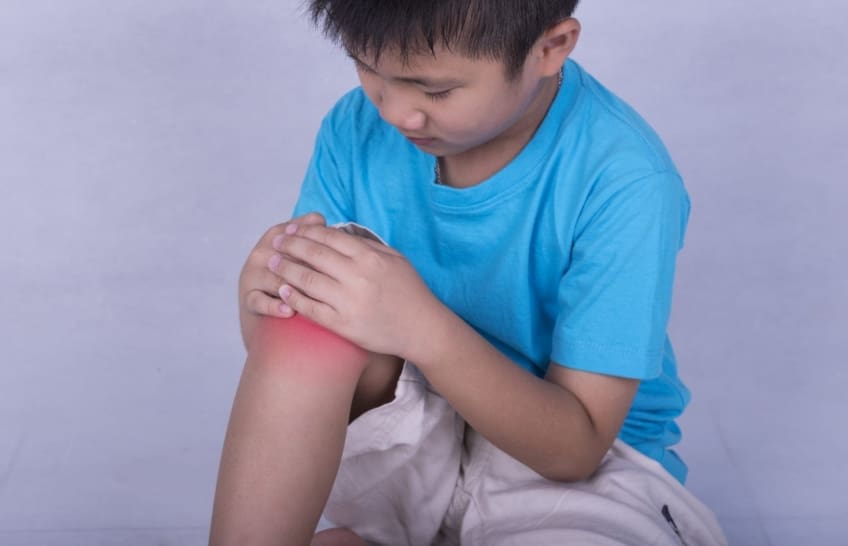
What is juvenile rheumatoid arthritis?
Juvenile rheumatoid arthritis is a disease. It causes joint pain and swelling. It typically starts before the age of 16 and is long-term. The disease is sometimes called juvenile idiopathic arthritis.


If you’re having joint pain, tell your family doctor. Treating early can help prevent or reduce lifelong disability. Read More
Symptoms of juvenile rheumatoid arthritis
Symptoms are different among children. Typically, joints become swollen, stiff, painful, and warm to the touch. They may start as early as 6 months of age. Your child may limp, especially in the morning when stiffness is the worst. They may have lower back pain and avoid normal activities. Symptoms may come and go. They may be mild or intense. Symptoms can last for a short time or for years. There are four types of juvenile rheumatoid arthritis. Symptoms depend on the type:
- Pauciarticular or “few joints.” This is the most common type. It affects 4 or fewer joints. These are usually the knee, leg, wrist, or jaw. It also can cause inflammation in the eyes. This is called iritis and is common in girls younger than 7. If not treated properly, it can damage vision. Boys older than 8 who have this type of arthritis often have spine and hip problems. This type often goes away in about 50% of cases.
- Polyarticular or “many joints.” This type of arthritis affects 5 or more small joints. This includes joints in the fingers and hands. Symptoms often appear in the same joints on both sides of the body. Other symptoms include a low fever, feeling tired and poor appetite. Your child may have a small rash on the lower torso and upper arms and legs. Some children with this disease have anemia (iron deficiency). In rare cases, this type can cause a child’s organs, such as the liver or spleen, to swell. This type happens more often in girls than in boys. This type only goes away in fewer than half of children who have it.
- Systemic or Still’s disease. This type is the least common. It can affect several areas of the body, including joints and organs. Early symptoms include a rash, chills, and a high fever. Anemia is another common symptom. This type of arthritis is likely to cause long-term joint damage. About half of children who have this type recover. The rest have joint pain and stiffness for many years.
- Spondyloarthritis. This type affects the joints located between the bottom of the spine and pelvis. Symptoms resemble adult arthritis.
Serious cases of juvenile rheumatoid arthritis can affect a child’s growth. See your doctor if your child has symptoms of juvenile rheumatoid arthritis.
What causes juvenile rheumatoid arthritis?
The cause of the disease is not known. Doctors suspect it is caused by an autoimmune illness. This is when your body attacks and destroys its own healthy tissue.
How is juvenile rheumatoid arthritis diagnosed?
Your child’s doctor will ask about your child’s symptoms and do a physical exam. It can be hard to diagnose. You doctor may do an X-ray or blood test to rule out other illnesses. X-rays also can show more severe damage or deformities. Your child’s doctor may want to take a sample of fluid from an actively inflamed joint or spinal fluid. It may take a few months before your doctor makes a diagnosis. This is so they can watch your child’s symptoms over time.
Can juvenile rheumatoid arthritis be prevented or avoided?
Juvenile rheumatoid arthritis cannot be prevented or avoided. Certain lifestyle changes can lessen your child’s discomfort. This includes exercise (walking, biking, and swimming). Warm up before exercising. A physical therapist can offer your child a plan for home exercises. Ask your doctor about seeing a physical therapist for home exercise to reduce pain.
Juvenile rheumatoid arthritis treatment
Your doctor may recommend medicine for pain and swelling. This includes both prescription and over-the-counter medicine. Over-the-counter medicine includes nonsteroidal anti-inflammatory drugs (NSAID.) This includes ibuprofen (brand names: Advil, Motrin). It reduces joint swelling.
If this does not help, your child’s doctor may suggest more powerful NSAIDs. This would be a prescription. For severe symptoms, your child’s doctor may need steroid treatments to reduce swelling. Your child’s doctor may prescribe medicine to treat an autoimmune illness. These medicines slow your child’s immune system to reduce further joint damage.
Children rarely need surgery to treat the disease. Badly damaged joints may require soft tissue surgery. This is if the joints are bent or deformed. Joint replacement surgery can help badly damaged joints. With proper treatment, many children lead full, normal, and symptom-free lives.
Living with juvenile rheumatoid arthritis
Whether your child’s symptoms come and go or are long-lasting some things can help. This includes:
- Taking a hot shower. Use a hot or cold pack or sleep in a warm bed to relieve stiffness.
- Stretching and do range-of-motion exercises. This reduces joint stiffness and improves flexibility. Exercise at the same time every day. Make it easy. Do it while watching TV or with family members.
- Taking medicine at the right time and consistently. Have your child take their medicine at the same time as another activity. This makes it easy to remember.
Being active is important in managing the disease. Children who have the disease may need emotional support. This is important in managing the anger and sadness of having the disease.
Questions to ask your doctor
- Will NSAIDs and other medicines cause ulcers or side effects?
- Are certain sports better than others?
- Can contact sports (football, basketball) cause more harm?
- Will this cause mobility problems for my child when they are older?
![]()
Copyright © American Academy of Family Physicians
This information provides a general overview and may not apply to everyone. Talk to your family doctor to find out if this information applies to you and to get more information on this subject.






